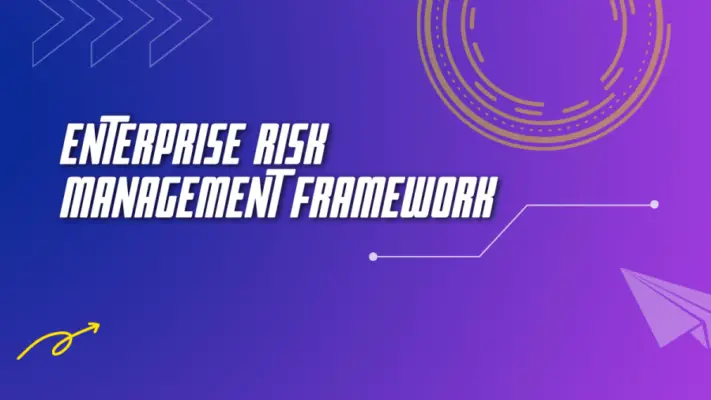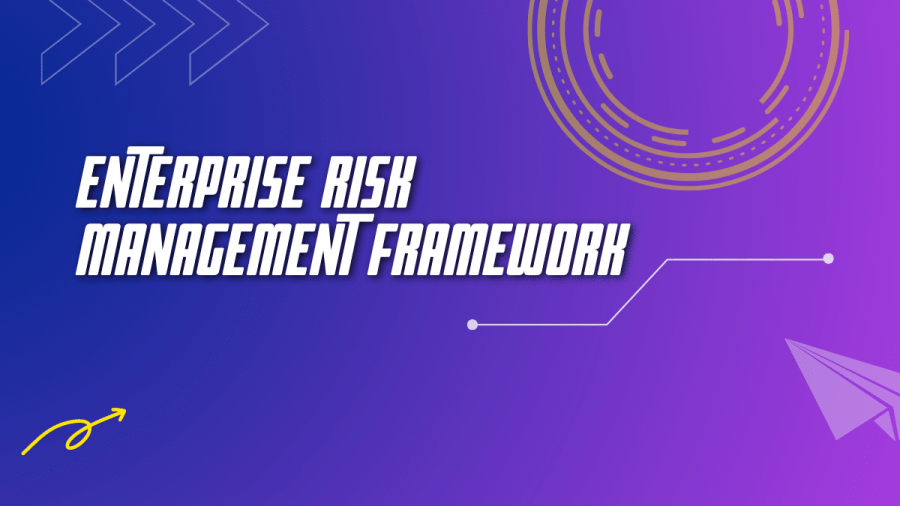Every business faces risks. Some of these are common to every industry, while others are specific to a particular type of company or location. In order for businesses to be successful in their goals and objectives, they must understand the risks that may affect them. This is where an enterprise risk management framework can help. With this tool in place, organizations can identify potential threats and act before they become problems.
Enterprise risk management is the process of identifying, assessing, and managing risks that could potentially have an adverse effect on an organization. Risk management is a key element in any business strategy because it helps to minimize threats while maximizing opportunities. An enterprise risk management framework can be set up by following these steps: identify risks; prioritize risks; determine how to mitigate them; monitor, and measure their effectiveness, and continuously update the risk assessment. Set up your own enterprise risk management framework today with this guide!
Every business faces risks. Some of these are common to every industry, while others are specific to a particular type of company or location. In order for businesses to be successful in their goals and objectives, they must understand the risks that may affect them. This is where an enterprise risk management framework can help. With this tool in place, organizations can identify potential threats and act before they become problems.
The world of business is changing faster than ever before. New technology, new competitors, and new regulations are forcing executives to rethink the very way they do business. As a result, risk management has become more important than ever for all businesses, and integrating risks with risk types in the risk registers encompasses an erm program that includes risk owners establishing ownership of potential risks
However, many organizations struggle with how to implement an effective enterprise-wide risk management framework that addresses their unique risks while also maximizing value creation across the entire organization. The good news is that there are several steps you can take today to set up your own ERM framework in order to achieve these goals.
One of the primary responsibilities of a company’s risk management function is to monitor and mitigate exposure mitigants. This includes identifying potential risks as well as determining an appropriate response strategy in case those threats actually unfold, such that losses can be limited through hedging or insurance policies. One way organizations meet their obligation under COSO enterprise risk management framework terminology covers both adverse events (a term used within ERM) and other types like volatility trends; creditworthiness ratings; legal proceedings
What is Risk Management?
Enterprise risks management is a definitive strategy based on a plan which targets the identification of and the management of any possible risks. This is very important for your firm as these risks can negatively impact your financial wellbeing and reputation. This gives management the opportunity to tackle uncertainties face-to-face and empowers them to grow the value chain. This is the ideal approach to risk management and how to mitigate against these risks differs depending on the organization’s structure and needs depending on the need and the size of the organization.
Enterprise risk management is just one component of an organization’s general erm program. It encompasses identifying, monitoring, and controlling risks at the enterprise level, in order to protect the resources that are essential for its operation.
First, it is helpful to define “enterprise”. Much like balancing your personal budget may be guided by understanding your individual financial health, enterprise risk management should be guided by evaluating an organization’s overall mission objectives and where investments are made. For example – a restaurant might define its mission as providing good food at affordable prices in a comfortable atmosphere while offering its employees reasonable hours. As such, total revenue may be deemed more important than net income or expenses.
Enterprise Risk Management Frameworks
An Enterprise risk management erm framework provides structured feedback and guidance for ERM managers from Business Units and senior management. An ERM framework helps establish a consistent culture of risk management no matter employee turnover or sector standards.
- It guides Risk Management functions.
- Helps enterprises control complexity,
- visualize risk through risk assessment, and identify risks
- Assign responsibility for identifying risk controls.
The framework supports the enterprise in integrating risk management into significant business activities and functions like managing risk checks and data visualizing risk complexity and assigning responsibilities.
The risk management process starts from risk identification, risk analysis, risk evaluation, and risk response. All these encompass the erm framework of an organization. The risk appetite policy and the statement are prepared by the board and risk committee. Risk appetite guides the thresholds of risk response strategies. It also ensures internal controls are enabled in risk over
A well-designed and all-inclusive ERM framework provide enterprises with a unified risk management practice. The enterprises face multiple challenges both positive and negative that can frighten the operation. A positive uncertainty would be possible for product innovation to lift a company in a new direction. A negative uncertainty may result from the threat that an opponent will steal the plans for the innovation and the manufacture. Each uncertainty is a risk. Successfully navigating these risks is often achieved as a business risk management strategy.
There is no one-size-fits-all framework and you begin to realize you have something else to look for. They advise on asking if any model is able to suit the organization’s individual demands. The Risk and Insurance Management Society offers a Risk Maturity Model (RMM).
The ISACA COBIT governance framework describes a process for balancing value with optimizing resource and risk. An ERM Framework can allow companies to combine all three factors and provide the pathway to meeting business goals. ERM may be used for the consolidation of risks, gain value and do the same in limited resources with reduced resources.

Guidance on Enterprise Risk Management
In 2004 international organization COSO erm framework (Sponsoring organizations)board appointed a framework to manage enterprise risks and published it. In addition, the new document outlines the importance of considering risks in the strategy-setting process as much as in improving performance. The revised version of the 2004 document addresses the era of risk management in the enterprise. It also addresses the need for business managers to adopt the most effective approach in managing risks and addressing them. Available at AICPA’s website.
Enterprise risk management is a strategic approach that identifies potential events that could negatively impact an organization’s objectives. It encompasses the following four elements of any risk-based decision-making process: (1) risk framing, which specifies how different risks are characterized and defined through objective setting; (2) identification and analysis of external threats, which includes assessing factors that can result in those risks as well as analyzing how likely those risks will occur; (3) assessment of those factors to determine severity; and (4) aggregation and prioritization categorization, which organizes and prioritizes all identified risks by their severity levels. Through this process, it should be possible to decide which impacts could impede an organization.
How is an ERM Framework Implemented in an Enterprise?
ERM process generally follows those that are defined by ISO 31000. Every organization operates in a unique environment and should maintain an acceptable level of any kind of strategic risk and risk oversight. Risk managers often overlook risks because of fear that they’ll never get noticed or that their problems will eventually be resolved later. Developing a process to control risks via a continuous feedback system will increase opportunities as well as minimize detrimental situations.
To address various types of risk there can be processes implemented by different teams which may address numerous risks simultaneously. As a result, the teams have understood and met risk and performance expectations and work within their own programs to achieve their risk programs, according to the statement. Risks tracked and reported by risk registers were aggregated.
components of an ERM framework ( Risk Appetite)includes:-
- Integration
- Design implementation
- Evaluation, and improvement – depend on leaders creating a cultural environment that values transparency and accountability.
This accountability must be universal in the business enterprise e.g. board of directors and executives through the leadership of business units and ultimately all members of the company depending on the risk tolerance: “Leadership and engagement is a necessity for all processes” for enterprise risk management.
Customization of the framework is easy and doesn’t have to involve many stakeholders. There is various use of a step-by-step procedure to establish an ERM application. The roadmap can be based on existing management and operational risk frameworks, the ERM model, and input from industry experts. Your approaches to risk management influence your total potential in managing risk. The approach should conform to your organization’s growth strategy. The strategy should follow the business’s growth strategy.
Risk oversight of risk functions performed by the board of directors and risk committee ensures internal controls are well established to identify potential events/external risks of risk event and risk responses . The effectiveness of internal controls

Why do Organizations Manage Risk(Risk Appetite)?
To be successful in the midst of rising market volatility one has to take some calculated risks. Moreover, that requirement requires a transcendent attitude to gain advantages in the game. Ideally, an organization must set some guidelines or standards on how everybody keeps their balance of risk-averse and aggressive. Running safely with no leaping may not always give you a competitive advantage. Nokia did not take on the new android platform changing platform and all know how things ended. Let’s jump into the concepts covering the range of ERM and give an example of ERM.
Senior managers usually participate in the process of managing risk, such as by assessing and prioritizing the risks faced by their organization. Organizations manage risk because it’s crucial to prepare for past, present and future contingencies that might disrupt business operations or produce financial loss — critical factors that determine an organization’s success.
Strategic risk management is a process of analyzing possible events with potential negative effects and selecting those events with the greatest probability and severity so they can be prepared for, planned around, or mitigated against to minimize the damage they might cause. As such, strategic risk management extends beyond singular event-based approaches (e.g., addressing only natural disasters.
Formulation of risk appetite by senior management is crucial for a common erm language establishing context for a control framework. Through objective setting internal environment and external context using a risk based approach to identify entity objectives to provide reasonable assurance to enterprise operations.
ERM framework manages risks in a risk environment taking into account risk tolerance thresholds in a risk management plan business objectives. Senior management discusses key erm principles and captures key risks in a strategy setting capturing strategic risks thus mitigate risk. A common risk language in monitoring risks of internal control will increase the risk-aware culture of the organization. Risk Awareness sessions on operational risks risk identification will inform the enterprise risk management erm risk appetite of particular risks improving risk management of the firm.
Organizations manage risk to be prepared for every eventuality that they may face. The main drivers of risk are cost, consequences, adequacy of controls, and likelihood.
Every organization has a unique–and different–risk appetite statement that outlines how it handles various risks. Some organizations want transparency in their risk appetite statements so even senior management can understand what is supported by the board. If you’re not careful about handling risk in your organization, you could lose clients or cause disaster when disaster strikes with disastrous consequences because your company lacked adequate controls or was oblivious to certain risks when they were more likely than experts thought they might be
An organization’s culture can either minimize or amplify people’s concerns about taking on new challenges and opportunities with key performance indicators.
Guide on Enterprise Risk Management for Cloud Computing
The advisory committee on the risk mitigation and security aspect of cloud computing of the Treadway Commission issued the report. The guide provides an overall path to developing cloud-centric governance structures. The project was commissioned by COSO and coauthored by Mike Grob and Victoria Cheng, Managing Director in Crowe LLP’s consulting services. The revised guidance applies to the principles and guidance contained under the framework ERM/ERM – Integrating with strategic and performance.

Conclusion
The enterprise risk management framework is a tool that can help your organization identify and mitigate risks. We at risk publishing are here to help you with this process, as we have spent years developing our own ERM strategies for businesses large and small. Contact us today if you want to learn more about how we make sure organizations like yours stay safe from the dangers of doing business!
A risk management framework is essential for ensuring the health and integrity of internal control. The comprehensive ERM framework covered above covers each realm of risk mitigation. To adopt and form a customized framework that suits your business organization’s needs and increases the profits of your project.
Chris Ekai is a Risk Management expert with over 10 years of experience in the field. He has a Master’s degree in Risk Management from University of Portsmouth and is a CPA and Finance professional. He currently works as a Content Manager at Risk Publishing, writing about Enterprise Risk Management, Business Continuity Management and Project Management.

